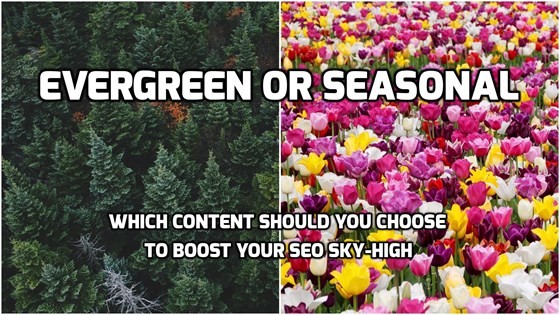Content drives online marketing strategies these days.
Marketers use a wide range of smart tools for developing content that perfectly matches the expectations of their audiences and builds a strong brand.
When it comes to basic types of content, marketers divide it into seasonal and evergreen.
Each of these types brings different benefits to brands. But how can you tell which works best for your audience?

Here's everything you need to know about seasonal vs. evergreen content to craft a winning content marketing strategy, boost your SEO, and convert more leads.
What is Evergreen and Seasonal Content?
Evergreen content lasts forever. It never goes out of date and it doesn't rely on temporary events.
For example, an article on how to tie a tie won't be affected by seasonal changes, new fashions, or recent developments. An evergreen piece of content remains relevant for as long as people engage in actions that make up its topic.
On the contrary, seasonal content is relevant for a short period of time.
It can be a 'quick-decay' type of content which has a defined end point when it's no longer relevant. For example, a post on content marketing trends for 2010 won't be useful for audiences trying to develop their strategies today.
Evergreen content lasts forever and won't be affected by seasonal changes, while seasonal content is relevant for a short period of time has a defined end point when it's no longer relevant.
A different sub type of seasonal content is topical content. This type of content is closely related to current developments in a sector.
It's usually directed at audiences who are well-versed with an industry. It features an in-depth and detailed analysis to help these audiences make better purchasing decisions.
Another type of seasonal content is the real seasonal content. It remains practical for a recurring season, holiday, or event.
For example, a blog post on how to prepare a house for winter colds will remain relevant every winter.
Now that you're aware of the basic differences between evergreen and seasonal content, here's everything you should know about their benefits and disadvantages.
Evergreen Content
Evergreen content has a lot more to offer when it comes to per-piece value.
Since it never expires, there's not chance of you getting your facts wrong. Imagine that a consumer stumbles upon a post you wrote in 2011 where you predicted trends which had never gained steam. This type of obsolete and wrong information might cause them to leave the website with a negative impression of your brand.
Another serious advantage of evergreen content is that it's much less demanding to produce. The information is always there, and you don't need to rush in publishing it. Since the topic is well-covered, you'll have plenty of sources to work with too.
Evegreen content gets more page views. A blogger from Coschedule noticed that two of their blog posts received 58% less page views and brought in 88% fewer email subscribers during one month. When he tried to understand the cause, he noticed that the topics of these posts were seasonal and would seem outdated soon after they were published.
Moreover, evergreen content can be re-purposed to drive your content marketing campaign. Coschedule reported achieving 283% growth after re-purposing their evergreen content .
Seasonal Content
Seasonal content has its advantages as well.
For starters, you'll be facing far less competition when crafting your seasonal content.
Evergreen content is easier to create and more valuable, so many businesses in your niche are bound to opt for this type of content. This makes seasonal content a less competitive content niche.
Moreover, content about news attracts more attention. Sure, it's hard to prove that seasonal content attracts more readers than evergreen content. But if you choose to write about a topic consumers have encountered in many other places, you won't appeal to your audience as much as with a fresh subject.
News and seasonal content stands out, bringing brands most value upon the initial publication. It's relevant to the present concerns of your audience and shows that the brand is aware of what's happening in the industry.
It also shows that the company is trying to actively respond to the changing customer needs.
Evergreen or Seasonal?
Since both evergreen and seasonal content have their advantages, it's smart to opt for a combined model which makes the most out of both types.
Let's call this model a hybrid type. For example, you can dedicate 25% of your content marketing strategy to producing seasonal content, and devote the majority of your resources to developing high-quality evergreen content which your audience will enjoy all year long.
How do you split your content?
Everything depends on a range of factors like your audience, competitors, and brand image. Your editorial calendar should incorporate both kinds of content to support your content marketing strategy.
Use analytics tools to learn more about your audience and its preferences. Why not survey your audience as well? Check what similar businesses are doing in terms of content marketing. You don't want to use your resources to create content that ends up in a vacuum.
But turn your analytics inwards as well. You need to measure the performance of evergreen and seasonal pieces you published in the past - how else will you know which type works best for your brand?
Mix it up and experiment with different content formats. Outsource your content creation to repurpose your pieces of evergreen content.
That's how you build a content strategy that helps your brand skyrocket in search engines and engage your target audience.
See Also: What to Choose: Responsive Web Design or Adaptive Web Design?